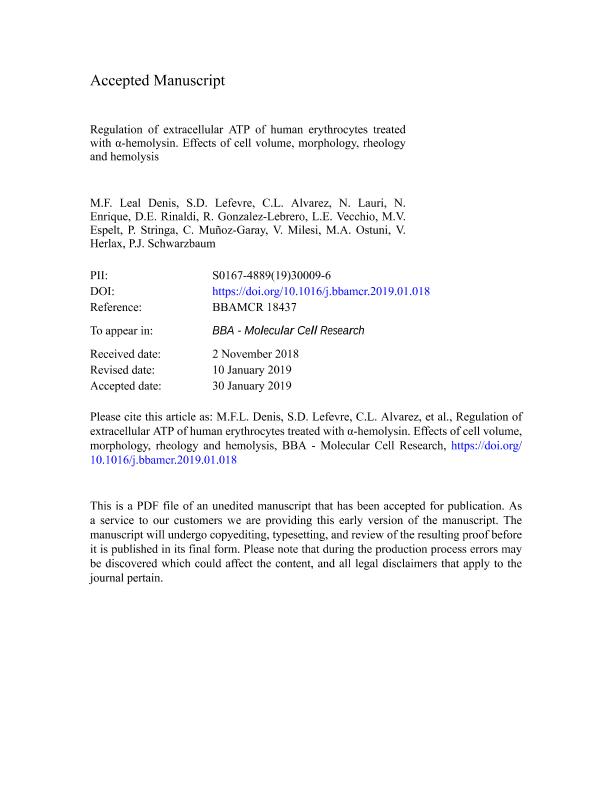Artículo
Regulation of extracellular ATP of human erythrocytes treated with α-hemolysin: Effects of cell volume, morphology, rheology and hemolysis
Leal Denis, Maria Florencia ; Lefevre, S.D.; Alvarez, Cora Lilia
; Lefevre, S.D.; Alvarez, Cora Lilia ; Lauri, Natalia; Enrique, Nicolás Jorge
; Lauri, Natalia; Enrique, Nicolás Jorge ; Rinaldi, Debora Eugenia
; Rinaldi, Debora Eugenia ; Gonzalez-Lebrero, Rodolfo Martin
; Gonzalez-Lebrero, Rodolfo Martin ; Vecchio Dezillio, Leandro Emmanuel
; Vecchio Dezillio, Leandro Emmanuel ; Espelt, Maria Victoria
; Espelt, Maria Victoria ; Stringa, Pablo Luis
; Stringa, Pablo Luis ; Muñoz Garay, C.; Milesi, Verónica
; Muñoz Garay, C.; Milesi, Verónica ; Ostuni, M.A.; Herlax, Vanesa Silvana
; Ostuni, M.A.; Herlax, Vanesa Silvana ; Schwarzbaum, Pablo Julio
; Schwarzbaum, Pablo Julio
 ; Lefevre, S.D.; Alvarez, Cora Lilia
; Lefevre, S.D.; Alvarez, Cora Lilia ; Lauri, Natalia; Enrique, Nicolás Jorge
; Lauri, Natalia; Enrique, Nicolás Jorge ; Rinaldi, Debora Eugenia
; Rinaldi, Debora Eugenia ; Gonzalez-Lebrero, Rodolfo Martin
; Gonzalez-Lebrero, Rodolfo Martin ; Vecchio Dezillio, Leandro Emmanuel
; Vecchio Dezillio, Leandro Emmanuel ; Espelt, Maria Victoria
; Espelt, Maria Victoria ; Stringa, Pablo Luis
; Stringa, Pablo Luis ; Muñoz Garay, C.; Milesi, Verónica
; Muñoz Garay, C.; Milesi, Verónica ; Ostuni, M.A.; Herlax, Vanesa Silvana
; Ostuni, M.A.; Herlax, Vanesa Silvana ; Schwarzbaum, Pablo Julio
; Schwarzbaum, Pablo Julio
Fecha de publicación:
05/2019
Editorial:
Elsevier
Revista:
Biochimica et Biophysica Acta-Molecular Cell Research
ISSN:
0167-4889
Idioma:
Inglés
Tipo de recurso:
Artículo publicado
Clasificación temática:
Resumen
Alpha-hemolysin (HlyA) of uropathogenic strains of Escherichia coli irreversibly binds to human erythrocytes (RBCs) and triggers activation of ATP release and metabolic changes ultimately leading to hemolysis. We studied the regulation of extracellular ATP (ATPe) of RBCs exposed to HlyA. Luminometry was used to assess ATP release and ATPe hydrolysis, whereas changes in cell volume and morphology were determined by electrical impedance, ektacytometry and aggregometry. Exposure of RBCs to HlyA induced a strong increase of [ATPe] (3–36-fold) and hemolysis (1–44-fold), partially compensated by [ATPe] hydrolysis by ectoATPases and intracellular ATPases released by dead cells. Carbenoxolone, a pannexin 1 inhibitor, partially inhibited ATP release (43–67%). The un-acylated toxin ProHlyA and the deletion analog HlyA∆914-936 were unable to induce ATP release or hemolysis. For HlyA treated RBCs, a data driven mathematical model showed that simultaneous lytic and non-lytic release mainly governed ATPe kinetics, while ATPe hydrolysis became important after prolonged toxin exposure. HlyA induced a 1.5-fold swelling, while blocking this swelling reduced ATP release by 77%. Blocking ATPe activation of purinergic P2X receptors reduced swelling by 60–80%. HlyA-RBCs showed an acute 1.3–2.2-fold increase of Ca 2+ i, increased crenation and externalization of phosphatidylserine. Perfusion of HlyA-RBCs through adhesion platforms showed strong adhesion to activated HMEC cells, followed by rapid detachment. HlyA exposed RBCs exhibited increased sphericity under osmotic stress, reduced elongation under shear stress, and very low aggregation in viscous media. Overall results showed that HlyA-RBCs displayed activated ATP release, high but weak adhesivity, low deformability and aggregability and high sphericity.
Palabras clave:
ADHESION, AGGREGATION
,
ATP-TRANSPORT
,
E.COLI
,
HEMOLYSIN
,
HEMOLYSIS
Archivos asociados
Licencia
Identificadores
Colecciones
Articulos(INIBIOLP)
Articulos de INST.DE INVEST.BIOQUIMICAS DE LA PLATA
Articulos de INST.DE INVEST.BIOQUIMICAS DE LA PLATA
Articulos(IQUIFIB)
Articulos de INST.DE QUIMICA Y FISICO-QUIMICA BIOLOGICAS "PROF. ALEJANDRO C. PALADINI"
Articulos de INST.DE QUIMICA Y FISICO-QUIMICA BIOLOGICAS "PROF. ALEJANDRO C. PALADINI"
Citación
Leal Denis, Maria Florencia; Lefevre, S.D.; Alvarez, Cora Lilia; Lauri, Natalia; Enrique, Nicolás Jorge; et al.; Regulation of extracellular ATP of human erythrocytes treated with α-hemolysin: Effects of cell volume, morphology, rheology and hemolysis; Elsevier; Biochimica et Biophysica Acta-Molecular Cell Research; 1866; 5; 5-2019; 896-915
Compartir
Altmétricas



